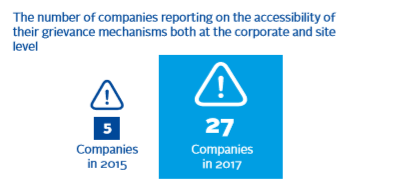High-level trends
Stakeholder engagement
- Just over half the companies reported on stakeholder engagement in 2015, while as of 2017 almost all of them do. Companies that already reported on this indicator have strengthened their level of disclosure and the overall quality of stakeholder engagement.
- Companies participating in multi-stakeholder initiatives often score higher than their peers in the benchmarking of disclosure.
Grievance mechanisms - accessibility
- The number of companies reporting on the accessibility of their grievance mechanisms both at the corporate and site level went from five in 2015 to twenty-seven in 2017. Improvement was registered across all categories. This makes it one of the indicators with most improvement.
Grievance mechanisms - means of communication and involving stakeholders
- From 22 companies disclosing in 2015, there are now 26, with nine having strengthened their level of disclosure.
Grievance mechanisms - processing grievances
- The number of companies that publicly report on how they process complaints filed through their grievance mechanisms has tripled from nine in 2015 to 27 in 2017.
Grievance mechanisms - tracking performance
- The number of companies reporting on how they monitor and assess the performance of their grievance mechanisms has doubled from nine in 2015 to 20 in 2017 – a reflection of improvements in disclosure across all companies. While no companies from emerging markets reported on this indicator in 2015, more than half of them now do.


What should investors look out for?
Stakeholder engagement
- No system or process to identify potentially affected stakeholders on an ongoing basis – and failure to identify most vulnerable groups.
- Lack of effective procedures to attain community consent, where applicable.
- No engagement is conducted with relevant stakeholders throughout the project life cycle – including during the exploration phase and through closure.
- Results of stakeholder engagement do not inform the company’s understanding of risks or how to address them.
Grievance mechanism - accessibility
- Grievance mechanism is available at corporate but not site level.
- Grievance mechanism is made available only to the company’s workers – not extended to suppliers/ contractors and potentially affected stakeholders.
Good practice: stakeholder engagement
Across Newmont’s operational sites, the company conducts a local stakeholder mapping process to identify, analyse and document individual and groups of stakeholders and their relationships with the project area. Sites must also develop a process to analyse stakeholder risks, conflicts, concerns, complaints and expectations. The stakeholder engagement plan should include a summary of key issues and a prioritised list of stakeholders based on influence and impact – indigenous peoples must also be consulted using appropriate representative bodies. The company has a standalone sustainability and stakeholder engagement policy supported by their stakeholder relationship management standard. Community input is sought throughout the project and during HRIA, and final reports are made available to local communities.
Grievance mechanisms - means of communication
- Failure to implement grievance mechanism at group and site level.
- Means through which complaints can be made are unclear and are not tailored to local contexts.
- Grievances cannot be made anonymously.
- Stakeholders are not consulted in the design, revision and monitoring of the grievance mechanism.
Good practice: grievance mechanisms, accessibility
Newmont employs three primary grievance mechanisms for internal and external stakeholders to raise issues related to human rights. The first is an internal grievance mechanism for workers to file grievances and complaints either through their managers or an HR representative. The second is a site-level mechanism, required for all sites, that aim to address external stakeholder concerns. The third is the ethics solution tool – a confidential channel for workers and external stakeholders to report any concern about compliance with the code of conduct, including potential human rights issues.
Grievance mechanism - processing grievances
- No information is provided on how the company address grievances.
- Lack of independent grievance assessments.
- Process to address grievances is unclear and no line of accountability at site level or corporate level is defined.
- No clear timeline is provided for processing grievances.
Good practice: grievance mechanisms, processing grievances
Anglo American describes at length in its SEAT toolbox the social incident (including complaints and grievances) management process. Once the complaint is reported and initially assessed to determine the level of severity, it is recorded on the information system by the complaints coordinator who sends a receipt of complaint and outlines how the latter will be processed. The relevant functions are notified and senior management responsibility is assigned to investigate and address the complaint. The investigation – which may entail engaging with external stakeholders – consists of three phases that lead to the development of conclusions and preventative actions: preparation, data gathering and data analysis. Once the investigation concludes, the company disseminates the learning into its internal processes.
Good practice: grievance mechanisms, means of communicating and involving stakeholders
Eldorado Gold has a company-wide grievance mechanism, comprising a global directive and implementation guide for each site. As part of its code of business, conduct and ethics, the company has a whistleblowing policy so that any stakeholder – internal or external – can confidentially report any concerns. In addition, each of the company’s operations has established various mechanisms for receiving and responding to external grievances. Concerns are managed by an external whistleblower reporting agency. All submissions and investigations are overseen by the company’s audit committee chair and corporate secretary.
Grievance mechanisms - tracking performance
- Failure to provide basic information on grievances (e.g. number of grievances filed).
- Failure to track trends relatively to the grievances (e.g. most recurring themes).
- Lack of information on the outcome of grievances (e.g. disciplinary action, remedy provided, etc.)
- Failure to establish how the information tracked informs the revision and monitoring of the grievance mechanism.
Good practice: grievance mechanisms, tracking performance
Glencore’s process is aligned with IFC Performance Standards and also refers to ICMM, World Bank and IFC guidelines specific to human rights and grievance mechanisms. Grievances are screened and assessed by the stakeholder response team. When a grievance is related to a contractor, it is transmitted directly to that contractor with a reply expected within two weeks. All communications are recorded and communicated to all appropriate parties to ensure compliance, and they support the contractor throughout the resolution process with the community. If a contractor does not address a grievance, this matter is raised with their stakeholder relations manager. When working to resolve each issue they take community preferences, project policy, past experience, current issues and potential outcomes into consideration. They monitor and report on the entire process to measure the effectiveness of their grievance management and the efficient use of resources. This also allows them to identify broad trends among the topics of grievances, and recurring problems. They can capture the lessons learned from each grievance and feed it into the continual improvement of individual projects and assets.
Download the full report
-

Digging deeper: human rights and the extractives sector
July 2018











